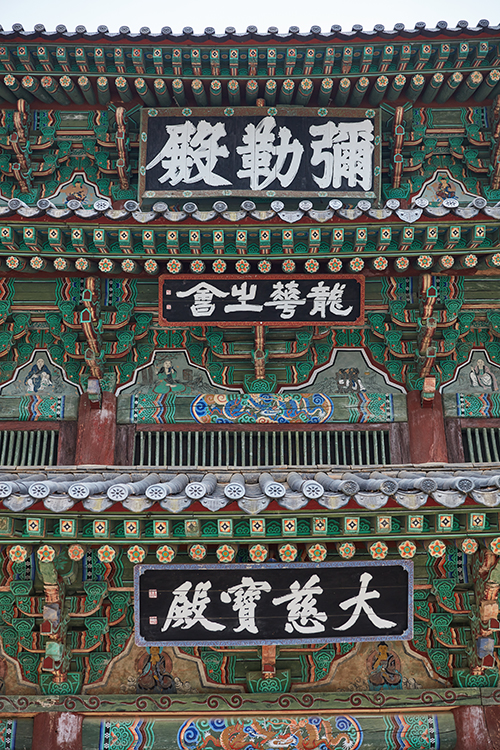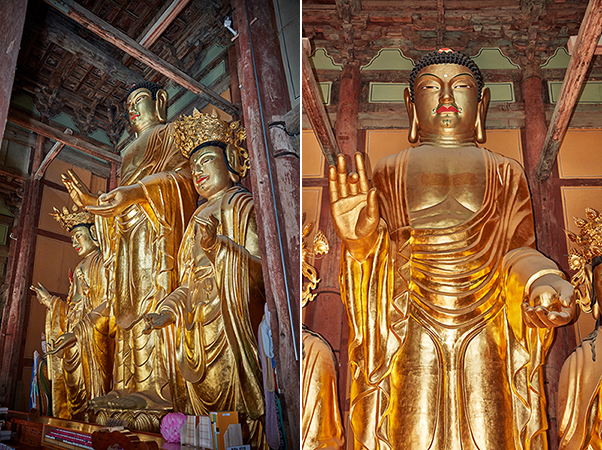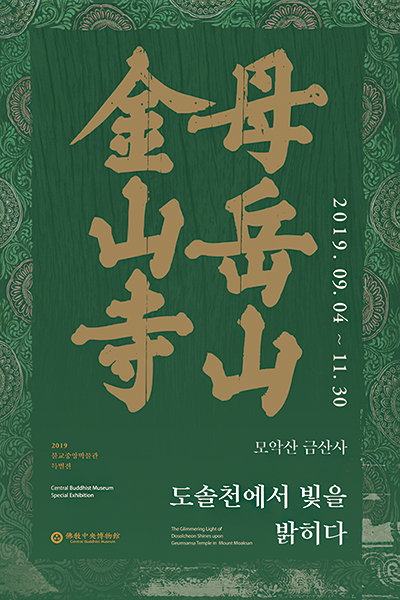English | Geumsansa: Dwelling of the Mireuk Buddha
Page information
Author Jogye On19-08-13 16:48 Views7,916 Comments0Related links
Body
Geumsansa: Dwelling of the Mireuk Buddha

1. Dosolcheon in the Mundane World: Geumsansa Temple in Mount Moaksan
Since the very beginning of its foundation, Geumsansa Temple has been standing proudly for the last 1,400 years at the western foothills of Mount Moaksan. Sticking out in the middle of vast Honam Plains, the southwestern part of the country, Mount Moaksan has been considered sacred from ancient times. Both of the names “Moaksan” and “Geumsansa” refer to big mountains, originating from the words, “Eom Moe,” and “Keum Moe.” The word “Eom Moe” means Mother Mountain, and the word “Keum Moe” refers to a gold mountain, providing the basis for their current names.
Despite its rich history, there are almost no documents or relics that can give us a glimpse of the original appearance of Geumsansa Temple at the time of its construction. Only Geumsansa Sajeok (Chronicle of Geumsansa Temple, 1653) stated, “In 599, King Beop of Baekje Kingdom (18 B.C. - 600 A.D.) took the throne and declared the law forbidding the killing of any living creatures. In the following year of 600, he ordained 38 Buddhists monks at Geumsansa and founded Wangheungsa Temple.” Since the Chronicle of Geumsansa Temple was written at a much later time, considering the fact of when the monastery was founded, it may not be reliable. Nonetheless, it seems to confirm the fact that Geumsansa Temple was founded in the period of Baekje Kingdom (18 B.C. - 600 A.D.) when examining the recording of other monks who resided at the monastery; how National Preceptor Jinpyo (713-780) joined the monastic order under the teaching of Master Seongje (崇濟法師) at Geumsansa and how Venerable Uijeok (義寂, 618 ~ ? ) from the Unified Silla period (668-935) dwelled in the temple. Regardless, it is speculated that the extent of Geumsansa Monastery at that time was not that substantial.
On the other hand, one record from the Joseon Dynasty period (1392-1910) stated that Geumsansa Temple was founded by Gyeonhwon (867-936) of Later Baekje Kingdom (892-936). Geumsansa Temple appears in the very famous story of Gyeon Hwon (867-936, r. 900-935), the monarch and the founder of Late Baekje (892-936), and Sin Geom (r. 935-936), his son. The history recounted that Gyeon Hwon was held captive in Geumsansa Temple by his son who usurped the throne. However, he escaped and surrendered to Wang Geon (847-918), the founder of the Goryeo Dynasty (918-1392), which became a very famous story. There was even a saying that Gyeon Hwon founded the temple Geumsansa as there are numerous sites related to him, such as “Hongye Mun or Gate” and “Seoksung, or Stone Fortress,” which are also called the part of “Gyeonhwon Fortress.”

2.Building the Basis for the Mireuk Faith, National Preceptor Jinpyo
Active during the reign of King Gyeongdeok, the 35th ruler (r. 742-765) of the Silla Kingdom (57 B.C. – 935 A.D.), National Preceptor Jinpyo (718 - ?) was practically regarded as the founder of Geumsansa since he laid the basis for the temple. The historical accounts of National Preceptor Jinpyo were relatively well recorded in the Memorabilia of the Three Kingdoms (三國遺事) and A Collection of Biographies of Buddhist Monks (續高僧傳) by Venerable Daoxuan (道宣) (596-667) of the Tang Dynasty period (618-907) in detail.
According to A Collection of Biographies of Buddhist Monks, National Preceptor Jinpyo was from Mangyeonghyeon, Wansanju (present-day Jeonju City in Jeolla Province). His father was Jin Naemal (眞乃末) and his mother was Gil Borang (吉寶娘). At the age of 12, he joined the monastic order and received ordination and the motivation behind his renunciation was well recorded in the text.
His family had been hunters for generations. As a child, he was fast and agile as well as an excellent archer. One day, while he was out on hunting and chasing after wild animals, he took a rest at a ridge next to a field. Then, he spotted a large number of frogs swarming near the water so he caught them all and tied them with willow branches. After hunting, he planned to take them home so he left them in the water, all bounded them up. Resuming hunting, he was so preoccupied with the chase that he ended up taking another route on the way back home and forgot all about the frogs. The next spring, while he was again out hunting, he heard the croaking of some frogs and looked into in the water. There, approximately 30 frogs were all tied up, croaking painfully. At last, he remembered the events that took place the previous year. Though he had forgotten all about them for the entire year, the tangled frogs had managed to survive. Regretful, he thought, ‘Ah, how I have caused such pain! How much have they suffered from the aching, having their lips and bellies all tied up together for a whole year?’ He felt remorse, cut the willow branches and let them free. This incident inspired him to give up living a secular life.
Subsequently, young Jinpyo left home to Geumsansa Temple and took the ordination under the teaching of Dharma Teacher Seungje. After he joined the monastic order, the National Preceptor ceaseless pushed himself to cultivate himself. Explicitly, as the title of a national preceptor indicates, he put a lot of emphasis on the importance of keeping the precepts. To earn the precepts, he conducted himself with thorough disciplining. After ascetic practices of exhausting his physical body (亡身懺法), he was rewarded with Jeonggye or 'pure precepts', but he didn’t stop training and went on to continue the practice. Ultimately, he received two rolls of the book the Sutra on the Divination to Examine the Karmic Retribution of Good and Evil Action (占察善惡業報經) from Mireuk or Maitreya, the Buddha of the future, along with 189 divination sticks in a mountain and came down.
After National Preceptor Jinpyo came down from the mountain and he expanded the temple, Geumsansa.
Upon receiving the teachings, Venerable Jinpyo came down from the mountain to expand the facilities. When he came around a big pond, the Dragon King appeared and presented a robe made with jade. Accompanied by 80,000 guards of the Dragon King, the venerable arrived at Geumsansa. In all directions, there came wind and the temple was made in just a few days.Then, Mireuk came down from the Dosolcheon (Tushita, the fourth level of the six heavenly realms of desire where happiness abounds) riding on clouds and gave precepts to the venerable.Thus, Venerable Jinpyo recommended others to take the precepts and commanded the construction a statue of Mireuk or Maitreya about one jang and 6 cheoks (16 cheoks, 16 * 34.48 centimeters) high, which is about 5.5 meters tall. Additionally, Venerable Jinpyo had a painting of Mireuk or Maitreya descending and giving the precepts depicted on the south wall of the main Buddha hall.
Due to the expansion by National Preceptor Jinpyo, Geumsansa was able to establish itself as the sizable monastery that we have now. Afterwards, National Preceptor Jinpyo also expanded Beopjusa Temple, the 5th District Main Temple of the Jogye Order of Korean Buddhism, in Mount Songni in Boeun, North Chungcheong Province, and founded Baryeosa Temple in Mount Kumgangsan, one of the best mountains in North Korea in succession.
The National Preceptor also put a lot of energy into edifying others. Particularly, he frequently held a Jeomchal Buddhist mass based on Jeomchal teaching, which involves observing one’s karmic effects on life from the past and into the future. Rooted in the Sutra on the Divination to Examine the Karmic Retribution of Good and Evil Action (占察善惡業報經), Jeomchal teaching tells one’s fortunes by rolling a sort of wooden wheel pieces and examining the shape they form. With the teaching of Jeomchal, one aims to learn about the sins of the past lives and repent. National Preceptor Jinpyo was known for doing Jeomchal, utilizing the 189 sticks that he received from Mireuk or Maitreya. Through the vehicle of Jeomchal teaching, he transmitted the Buddhist doctrines to common people with a sense of familiarity and used it to disseminate the Mireuk or Maitreya faith extensively.


3. Mireuk Buddha’s Doryang or Shrine
Mireuk is transliterated from the word ‘Maitreya’ in Sanskrit. Maitreya was predicted to be the next Buddha of the world, succeeding Sakyamuni Buddha. Presently, Mireuk is in Dosolcheon or the Tushita Heaven, preaching to heavenly beings. The prophecy states that Mireuk will emerge to this world 5,670 million years after the demise of Sakyamuni Buddha, give three dharma talks, and save all the sentient beings.
The Mireuk faith takes shape in two forms. The first one indicates that by keeping Gyeyul (Sila and Vinaya), or the rules that all Buddhist must observe everyday life and cultivating the ten venerable deeds or pure paths of action, even sentient beings can be reborn in Dosolcheon and meet Mireuk. The other one states that Mireuk will be born into this world, transform the place into Jeongto or the pure land through dharma talks, and save all the sentient beings.
After the guardianship of Venerable Jinpyo, Geumsansa became the headquarters of the Mireuk faith ever since. Mainly, the Mireuk belief is well depicted in the dharma hall Mireukjeon and three statues of Mireuk inside.
Enshrining three Mireuk statues, Mireukjeon is the main buddha hall of Geumsansa Temple. This is the only three-story dharma hall structure in the country that it is extremely significant in the history of Korean architecture as well. The original structure was burned down during the Imjin Japanese Invasion of 1592, but it was later reconstructed by Great Master Sumun in 1635. Unfortunately, there is no way of knowing how the original monastery looked like before its destruction. All that is known is from the reparation documents of the five-story stone pagoda of Geumsansa Temple recorded in 1492, stating that National Preceptor Jinpyo enshrined three large buddha statues on the third floor of Mireukdaejeon. Guessing from this record, the dharma hall must have been three floors since the time National Preceptor Jinpyo had expanded Geumsansa Temple. Uniquely, Mireukjeon has a different plaque on each floor. On the first floor, it is called Daejabojeon or the Hall of Great Mercy and Treasure; the second is Yonghwajiheo or the Hall of Gathering of Dragon and Beauty; the third is Mireukjeon or the Hall of Maitreya. All of them share the same theme of Mireuk’s residence.
Unlike the three-story outer structure, Mireukjeon has one big hall inside. Also, in the middle, the enshrined statues of Mireuk Buddha are about 12 meters tall. Just like Mireukjeon, the three Mireuk Buddha statues were enshrined by National Preceptor Jinpyo at first. It is said that National Preceptor Jinpyo had the statue of Mireuk made of bronze. However, the statues were burnt down along with Mireukjeon Hall during the Imjin Japanese Invasion of 1592 so they were re-enshrined during the construction of the main building. For four hundred years since their restoration, the Mireuk Buddhas guarded Geumsansa Temple, but they went through another big disaster during the Japanese Colonial rule (1910-1945). The main Mireuk Buddha was burnt to ashes by accident in 1935.
Originally, the main Buddha statue in the middle had been enshrined atop a large cauldron. Into the gap between the bottom of the statue and the caldron, Buddhist devotees would often insert cash offerings. Like any other day, on the night of March 9th, 1935, a child went into the caldron to gather the offerings with a lit candle in his hand. The candle fell and the main statue caught fire. Soon, the main statue succumbed to the blazing fire and crumbled into a pile of ashes on the ground. The abbot of Geumsansa, Venerable Hwang, Seongryeol tried to raise funds to re-enshrine the main Buddha and hold public bidding for the construction of the statue. For the bidding, traditional Buddhist monk painters Boeung, Seokseong, and Ilseop, along with a modern sculptor Kim Bokjin, who graduated from the Tokyo Fine Arts School participated. For his skill in combining traditional and modern art, Kim Bokjin was rewarded the reconstruction of the Mireuk statue of Geumsansa. Though Venerable Boeung and Venerable Ilseop were renowned Buddhist painters at that time, they didn’t have a lot of experience in sculpting the Buddhist statues.
Kim Bokjin (1901-1940) was a monumental sculptor who first incorporated western sculpting into Korean art. After graduating from the Tokyo Fine Arts School and coming back to Korea in 1925, he actively involved himself in various projects up until his death in 1940. In 1928, he was imprisoned for the crime of joining the Korea Artista Proleta Federacio (KAPF). During the seven years of his incarceration, he became deeply absorbed into Buddhism. When he was released from jail, he managed to sculpt several Buddhist statues for a short five years until his death.
For the construction of the big Buddha statue of Geumsansa, the sculptor, Kim, spent nearly 270 days working on the project. Finally, the great Mireuk Buddha statue was completed, incorporating the modern material of plaster into making the traditional Buddhist structure. This beautifully balanced and harmonized sculpture by Kim Bokjin is a monumental Buddhist statue in which the traditional Buddhist statue method that had been discarded was resurrected by a modern sculptor.

* Central Buddhist Museum Exhibition Information
The Glimmering Light of Dosolcheon Shines upon Geumsansa Temple in Mount Moaksan
Wednesday, September 4 to Saturday, November 30, 2019
Venue: Exhibition Hall at the Central Buddhist Museum
The special exhibition will feature Geumsansa Temple, its history from the very beginning to the present, and the Buddhist holy relics from Geumsansa and its branch monasteries.


